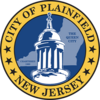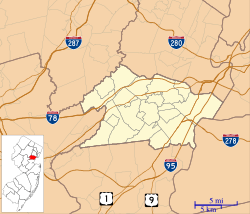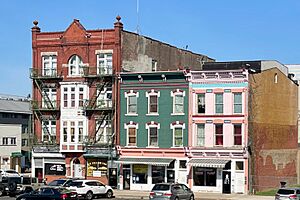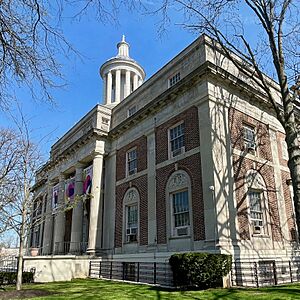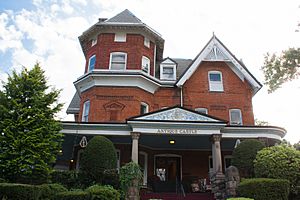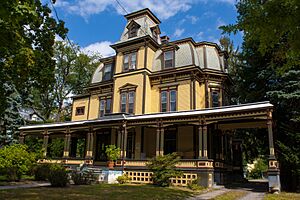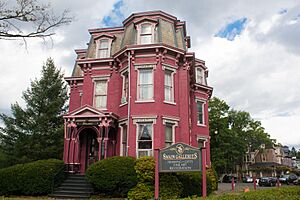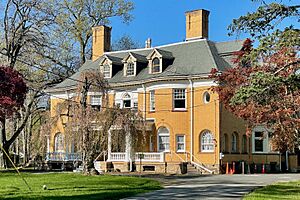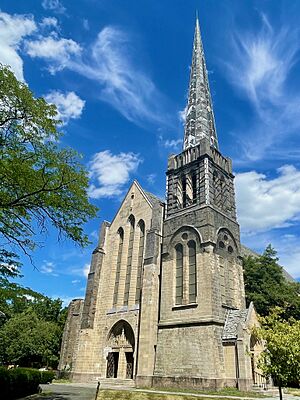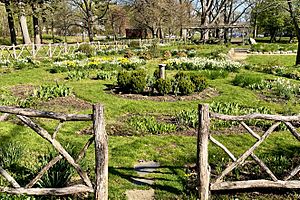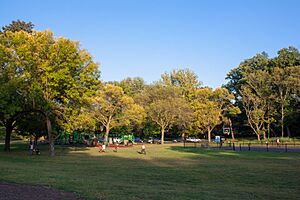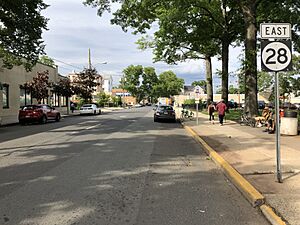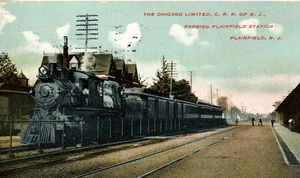Plainfield, New Jersey facts for kids
Quick facts for kids
Plainfield, New Jersey
|
||
|---|---|---|
|
City
|
||

Aerial photograph of Plainfield
|
||
|
||
| Nickname(s):
The Queen City
|
||
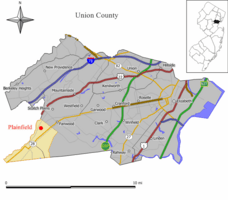
Location of Plainfield in Union County highlighted in yellow (left). Inset map: Location of Union County in New Jersey highlighted in black (right).
|
||
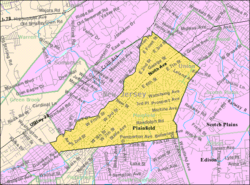
Census Bureau map of Plainfield, New Jersey
|
||
| Country | ||
| State | ||
| County | Union | |
| Incorporated | April 21, 1869 | |
| Government | ||
| • Type | Special charter | |
| • Body | City Council | |
| Area | ||
| • Total | 5.97 sq mi (15.46 km2) | |
| • Land | 5.96 sq mi (15.43 km2) | |
| • Water | 0.01 sq mi (0.02 km2) 0.15% | |
| Area rank | 258th of 565 in state 8th of 21 in county |
|
| Elevation | 95 ft (29 m) | |
| Population
(2020)
|
||
| • Total | 54,586 | |
| • Estimate
(2023)
|
54,670 | |
| • Rank | 738th in country (as of 2022) 34th of 565 in state 3rd of 21 in county |
|
| • Density | 9,160.3/sq mi (3,536.8/km2) | |
| • Density rank | 41st of 565 in state 3rd of 21 in county |
|
| Time zone | UTC−05:00 (Eastern (EST)) | |
| • Summer (DST) | UTC−04:00 (Eastern (EDT)) | |
| ZIP Codes |
07060–07063
|
|
| Area code(s) | 732 and 908 | |
| FIPS code | 3403959190 | |
| GNIS feature ID | 0885355 | |

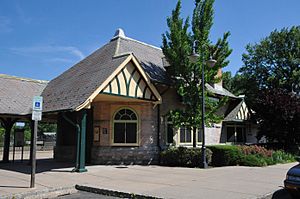
Plainfield is a city in Union County, New Jersey. It is known as "The Queen City." Plainfield is a regional center for Central New Jersey and a nearby city for people working in the New York Metropolitan area. It is located in the Raritan Valley region. In 2020, the city's population was 54,586. This was an increase of about 9.6% from 2010. In 2023, the population was estimated to be 54,670.
Plainfield was first set up as Plainfield Township on April 5, 1847. It was created from parts of Westfield Township. At that time, the area was part of Essex County. On March 19, 1857, Plainfield Township became part of the new Union County. Plainfield officially became a city on April 21, 1869. The name "Plainfield" comes from a local estate or its beautiful location.
Contents
- Plainfield's Past: A Look at History
- Plainfield's Location and Environment
- Plainfield's People: Demographics
- Plainfield's Economy and Business
- Plainfield's Historic Neighborhoods
- The West End: A Vibrant Community
- Plainfield's Arts and Culture Scene
- Plainfield's Media Outlets
- Places of Worship in Plainfield
- Plainfield's Parks and Recreation
- Plainfield's Government and Politics
- Plainfield's Schools and Learning
- Getting Around Plainfield: Transportation
- Health Care in Plainfield
- Plainfield Teacher's College Hoax
- Notable People from Plainfield
- More About Plainfield
- See also
Plainfield's Past: A Look at History
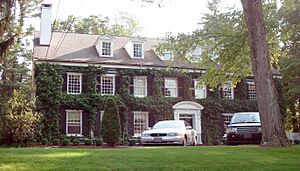
Plainfield was first settled in 1684 by a group called Quakers. It became a city in 1869. Plainfield has many different businesses, including printing and making chemicals, clothes, electronics, and car parts.
Several buildings from the 1700s are still standing. These include a Friends' meetinghouse (built in 1788), the Martine house (1717), and the Nathaniel Drake House (1746). The Drake House was used by George Washington during a battle in June 1777. Nearby Washington Rock is a high point in the Watchung Mountains. It is said that Washington watched British troops from there.
Why Plainfield is "The Queen City"
The nickname "Queen City" started in the late 1800s. Plainfield was known for having a good climate for people with breathing problems. In 1886, a local newspaper publisher named Thomas W. Morrison called Plainfield the "Colorado of the East." Since Denver, Colorado, was known as the "Queen City of the Plains," Plainfield's nickname became "The Queen City."
Music and Sports Legends from Plainfield
Plainfield is famous as the birthplace of P-Funk, a style of music. George Clinton started his group, The Parliaments, while working in a barber shop in Plainfield. Parliament-Funkadelic was honored in the Rock and Roll Hall of Fame in 1997.
Many famous athletes have lived in Plainfield.
- Milt Campbell won a gold medal in the Decathlon at the 1956 Olympic Games. He was the first African-American to do so.
- Joe Black was the first African-American pitcher to win a World Series game.
- Jeff Torborg was an MLB player, coach, and manager.
- Jay Williams played basketball for Duke University and the Chicago Bulls.
- Vic Washington was an NFL player.
Historic Homes and Neighborhoods
Plainfield has many beautiful old homes. Wealthy people from the 1800s and 1900s built these houses. After the railway opened, a part of the city became known as "Millionaires' Row." Many homes and areas in Plainfield are listed on the National Register of Historic Places.
The "Sleepy Hollow" area in the northeast part of the city is known for its lovely streets and homes. These houses were built mostly in the first half of the 1900s. They show many different architectural styles, from grand Queen Anne mansions to charming gingerbread cottages.
Changes in the City
In July 1967, Plainfield experienced civil unrest, similar to events in Newark. This led to changes in the city's population. Many white residents moved away, and the percentage of Black residents increased. Author Isaiah Tremaine wrote a book called Insurrection in 2017. It describes the events of the Plainfield unrest from his view as a Black teenager.
Before these events, Plainfield was a popular place for shopping and entertainment. People from nearby counties would come to shop in Plainfield's business districts. There were four movie theaters: the Strand, the Liberty, the Paramount, and the Oxford.
In 2025, Plainfield was affected by two natural disasters. On July 3, severe thunderstorms caused three deaths and left many without power. On July 14, flash floods killed two women when their car was swept into Cedar Brook.
Plainfield's Location and Environment
Plainfield covers about 5.97 square miles. Most of this is land, with a small amount of water.
Neighboring Towns
Plainfield is in Central Jersey. It borders nine other towns:
- In Union County: Scotch Plains (north and east) and Fanwood (northeast).
- In Middlesex County: South Plainfield and Piscataway (south), Dunellen (southwest), and Edison (southeast).
- In Somerset County: Green Brook Township (northwest), North Plainfield (north), and Watchung (northwest).
Plainfield is part of the Raritan Valley, a group of cities in central New Jersey. The Robinson's Branch of the Rahway River also flows through Plainfield.
Plainfield's Weather and Climate
Plainfield has a climate with cold winters and hot, humid summers. The lowest temperature ever recorded was -17°F (-27°C) on February 9, 1934. The highest temperature ever recorded was 106°F (41°C) on July 10, 1936, and August 11, 1949.
Plainfield's People: Demographics
Plainfield's population has changed over the years. The number of Latino residents has grown quickly. As of the 2020 census, more than half of the city's population is Hispanic.
| Historical population | |||
|---|---|---|---|
| Census | Pop. | %± | |
| 1870 | 5,095 | — | |
| 1880 | 8,125 | 59.5% | |
| 1890 | 11,267 | 38.7% | |
| 1900 | 15,369 | 36.4% | |
| 1910 | 20,550 | 33.7% | |
| 1920 | 27,700 | 34.8% | |
| 1930 | 34,422 | 24.3% | |
| 1940 | 37,469 | 8.9% | |
| 1950 | 42,366 | 13.1% | |
| 1960 | 45,330 | 7.0% | |
| 1970 | 46,862 | 3.4% | |
| 1980 | 45,555 | −2.8% | |
| 1990 | 46,567 | 2.2% | |
| 2000 | 47,829 | 2.7% | |
| 2010 | 49,808 | 4.1% | |
| 2020 | 54,586 | 9.6% | |
| 2023 (est.) | 54,670 | 9.8% | |
| Population sources: 1870–1920 1860–1870 1870 1880–1890 1890–1910 1870–1930 1940–2000 2000 2010 2020 |
|||
Plainfield's Population in 2020
In 2020, Plainfield had 54,586 people. The city's population density was about 9,160 people per square mile.
- 54.58% of the population was Hispanic or Latino.
- 34.87% was Black or African American.
- 6.20% was White.
- Other groups made up smaller percentages.
Plainfield's Population in 2010
In 2010, Plainfield had 49,808 people.
- 40.37% of the population was Hispanic or Latino.
- 50.20% was Black or African American.
- 23.54% was White.
- About 25.8% of the people were under 18 years old.
- The average household had 3.23 people.
Plainfield's Economy and Business
Parts of Plainfield are in an Urban Enterprise Zone. This program helps businesses and creates jobs. Shoppers in this zone pay a lower sales tax rate. This program was restarted in May 2018.
Downtown Plainfield has two historic business areas:
- The North Avenue Commercial District includes the train station, post office, and PNC Bank. Its buildings show 19th and early 20th-century styles.
- The Plainfield Civic District has buildings like City Hall and the YMCA. These buildings reflect the "City Beautiful Movement" style from the early 1900s.
Many community events happen downtown, like the Christmas Tree Lighting and the Queen City 5k run. The Downtown Plainfield Alliance (DPA) is a group that works to improve downtown Plainfield.
Plainfield's Historic Neighborhoods
Plainfield has several historic neighborhoods with beautiful old homes.
- The Van Wyck Brooks Historic District has over 150 properties. It was named one of the "Best Old House Neighborhoods" in 2012. This district is the largest of Plainfield's six historic residential districts. Its oldest building, the Manning Stelle Farmhouse, dates back to 1803.
- Netherwood Heights Historic District is near the Netherwood Train Station.
- Other historic districts include Crescent Area Historic District and Hillside Avenue Historic District.
- Sleepy Hollow is a section with grand homes on winding roads in the northeast part of the city.
The West End: A Vibrant Community
The West End of Plainfield is a historic African-American neighborhood. It is known for its strong community spirit. Part of the West End is called Soulville by locals.
Mount Olive Baptist Church has served the West End since 1870. It was Plainfield's first Black church. Other churches like Calvary Baptist Church (started in 1897) and Shiloh Baptist Church (started in 1908) grew from Mount Olive. These churches offer many community events.
The West End has seen more Latino residents in recent years. In 2020, 51% of Plainfield's population was of Hispanic origin. This growth has brought new life and energy to the city.
Parliament-Funkadelic Way
The West End was once home to the Silk Palace, a barbershop partly owned by music legend George Clinton. This shop was a popular spot for local singers and musicians in the 1950s and 1960s. In 2022, a part of Plainfield Avenue was renamed "Parliament Funkadelic Way" to honor this musical history.
Plainfield's Arts and Culture Scene

Plainfield has a rich arts and culture scene:
- The Queen City Film Festival celebrates independent films each fall.
- Bill Evans, a famous jazz piano artist, was born in Plainfield.
- George Clinton founded The Parliaments in Plainfield.
- Soul singer Lee Fields lives in Plainfield.
- The Plainfield Symphony, founded in 1919, is one of the oldest orchestras in the U.S.
- The 1990s R&B group Total is from Plainfield.
- The duCret School of Art, founded in 1926, is New Jersey's oldest art school.
- The Swain Galleries, founded in 1868, are the oldest privately owned art gallery in the state.
- Music in the Park is an annual summer concert event.
- The Plainfield Cultural Center has a theater and a sanctuary for performances.
- The Plainfield Music Store, founded in 1951, has a large collection of sheet music.
- The French School of Music, founded in 1927, offers music lessons.
- The Crescent Concerts series brings high-quality music performances to the city.
- The Queen City October Music Festival is an annual music festival.
- Shiloh Baptist Church hosts Jazz In The Sanctuary events.
- DreamHouse Theater Company performs plays and musical shows.
- The character John McClane from the A Good Day to Die Hard movie is said to be from Plainfield.
- J.M. Benjamin, a Plainfield author and filmmaker, won an award for his short film Moves We Make, which was filmed in Plainfield.
Plainfield's Media Outlets
Plainfield has several local news sources:
- TAPinto Plainfield is an online news site.
- Union News Daily covers Union County news, including a section for Plainfield.
- PCTV (Plainfield Community Television) is the city's own TV channel.
Larger newspapers that cover Plainfield include the Courier News and The Star-Ledger. The Courier News used to be based in Plainfield until 1972.
Places of Worship in Plainfield
Plainfield has many places of worship:
- Saint Mary's Catholic Church was built in the 1870s.
- Grace Church, founded in 1852, is a national historic site.
- First Park Baptist.
- Albaseerah Islamic Center is a mosque.
- First Unitarian Society of Plainfield, founded in the 1880s, is the oldest Unitarian congregation in the U.S.
- Bethel Presbyterian Church.
- Crescent Avenue Presbyterian Church.
- The Mt. Olive Baptist Church.
- Plainfield Friends Quaker Meeting House.
- Seventh Day Baptist Church.
- St. Bernard of Clairvaux & St. Stanislaus Kostka.
- Shiloh Baptist Church, established 1908.
- The United Presbyterian Church 1825.
- New Covenant Church, Pentecostal.
- Cross of Life Lutheran Church (ELCA).
- Ruth Fellowship Ministries.
Plainfield's Parks and Recreation
Plainfield offers many parks and recreation spots:
- Tëmike Park, opened in June 2022, is an inclusive playground in Cedar Brook Park.
- Cedar Brook Park is on the west side of the city.
- Green Brook Park has hiking trails, sports areas, and picnic spots.
- The Plainfield Garden Club, founded in 1915, maintains the Shakespeare Garden in Cedar Brook Park. This garden is one of only 23 Shakespeare Gardens in the U.S.
- The hiking trails of the Watchung Reservation are close by.
- Plainfield Skatepark at Madison Park opened in 2017. It is the city's first public skatepark.
- Milt Campbell Field, named after the Olympic gold medalist, offers sports and nature walks.
- Hannah Atkins Center Pool, Rushmore Playground Pool, and Seidler Field Pool provide swimming and other activities.
Plainfield's Government and Politics
Plainfield is run by a mayor and a seven-member city council. All serve four-year terms. The city has four wards, and one council seat from a ward is elected each year. There are also three "at-large" seats that represent larger areas or the whole city.
As of 2024, the Mayor of Plainfield is Democrat Adrian O. Mapp. The City Council members include Steve G. Hockaday (Council President), Robert K. Graham (Council Vice President), Terri Briggs-Jones, Julienne Cherry, Charles McRae, Darcella Sessomes, and Richard Wyatt.
Plainfield's Political Views
Plainfield tends to vote for Democratic candidates. In the 2020 presidential election, most votes went to the Democratic candidate. The city also largely supported Democratic candidates in the 2017 and 2013 gubernatorial elections.
Plainfield's Schools and Learning
Plainfield has a public school district that serves students from kindergarten through 12th grade. The district has 14 schools and about 10,097 students.
Plainfield Public Schools
Schools in the district include:
- DeWitt D. Barlow Elementary School (K–5)
- Charles and Anna Booker Elementary School (PreK–5)
- Cedarbrook K-8 Center (K–8)
- Clinton Elementary School (K–5)
- Frederic W. Cook Elementary School (K–5)
- Emerson Community School (K–5)
- Evergreen Elementary School (K–5)
- Jefferson Elementary School (K–5)
- Charles H. Stillman Elementary School (K–5)
- Washington Community School (K–5)
- Frank J. Hubbard Middle School (6–8)
- Maxson Middle School (6–8)
- Pinnacle Academy High School (9–12)
- Plainfield Academy for the Arts and Advanced Studies (7–12)
- Plainfield High School (9–12)
Plainfield is also home to New Jersey's first high school focused on sustainability, the Barack Obama Green Charter High School.
Private Schools in Plainfield
Koinonia Academy is a private school in Plainfield. It serves students from Pre-K through 12th grade.
Higher Education in Plainfield
Union College, a community college, has a campus in downtown Plainfield.
Getting Around Plainfield: Transportation
Plainfield has over 100 miles of roads. The main road through Plainfield is Route 28. Larger highways like U.S. Route 22, Interstate 287, and Interstate 78 are easily reached from Plainfield.
Trains and Buses
Plainfield has two NJ Transit train stations on the Raritan Valley Line:
- The main Plainfield station is downtown.
- The smaller Netherwood station is in the Netherwood section.
These trains connect to Newark and New York City. NJ Transit also provides bus service to Midtown Manhattan and Newark, as well as local bus routes. Newark Liberty International Airport is about 30 minutes away.
Health Care in Plainfield
Neighborhood Health Services Corporation (NHSC) is a non-profit health center in Plainfield. It provides health care services to the community. NHSC helps patients get medicines at lower prices. In the past, Plainfield was known for having many doctors' offices, especially along Park Avenue, which was called "Doctors Row."
Plainfield Teacher's College Hoax
The "Plainfield Teacher's College" was a fake school made up in 1941 by two college football fans. Their imaginary football team's scores were even printed in major newspapers like The New York Times before the trick was found out.
Notable People from Plainfield
- Ernest R. Ackerman (1863–1931), politician
- John Adams (1772–1863), educator
- Katherine Langhorne Adams (1885–1977), painter
- Erika Amato (born 1969), actress and singer
- Donald C. Backer (1943–2010), radio astronomer
- Rich Bagger (born 1960), former mayor
- John Drayton Baker (1915–1942), Naval aviator
- Jeff Barry (born 1938), songwriter and producer
- Ann Baumgartner (1918–2008), aviator
- James Bell (born 1992), basketball player
- G. P. Mellick Belshaw (1928–2020), bishop
- Charlie Bicknell (1928–2013), MLB pitcher
- Joe Black (1924–2002), professional baseball player
- Judy Blume (born 1938), author
- Jon Bramnick (born 1953), politician
- Anthony Branker (born 1958), jazz musician
- Jack E. Bronston (1922–2017), lawyer and politician
- Van Wyck Brooks (1900–1986), author
- Brock Brower (1931–2014), novelist and TV writer
- Glenwood Brown (born 1967), professional boxer
- Milt Campbell (1933–2012), Olympic gold medalist
- Pete Carmichael (1941–2016), football coach
- Leonte Carroo (born 1994), NFL wide receiver
- Linda S. Carter (born 1963), politician
- Jeremiah E. Cary (1803–1888), U.S. Representative
- W. Sterling Cary (1927–2021), church leader
- James Herbert Case Jr. (1906–1965), college president
- Diane Chamberlain, author
- DJ Cheese, world champion DJ
- John Chironna (1928–2010), football coach
- Rohit Chopra (born 1982), government official
- Earl Clark (born 1988), basketball player
- George Clinton (born 1941), musician
- Manny Collins (born 1984), football player
- Richard Guy Condon (1952–1995), anthropologist
- William Consovoy (1974–2023), attorney
- Archibald Cox (1912–2004), Watergate prosecutor
- Kathy Cox (born 1964), former state school superintendent
- Dan Davis (born 1986), football player
- Pat DiNizio (1955–2017), lead singer of The Smithereens
- Charles C. Dodge (1841–1910), Civil War general
- Barbara L. Drinkwater (1926–2019), sports physiologist
- William Archibald Dunning (1857–1922), historian
- Bill Evans (1929–1980), jazz pianist
- Alfred A. Farland (1864–1954), banjoist
- Dionne Farris (born 1969), singer
- Negley Farson (1890–1960), journalist and author
- J. Michael Fay (born 1956), conservationist
- Rashan Gary (born 1997), football player
- Glenn Goins (1954–1978), singer and guitarist
- Gertrude Joy Grimm (1904–1988), WAVES officer
- Jan Groover (1943–2012), photographer
- Mark Haines (1946–2011), TV host
- David Hand (1900–1986), animator
- Bret Harte (1836–1902), author and poet
- Eddie Hazel (1950–1992), guitarist
- William Hazell (1908–1995), college president
- Elise B. Heinz (1935–2014), lawyer and politician
- Richard X. Heyman, singer-songwriter
- Jon Hilliman (born 1995), professional football player
- Byron Hurt (born 1969), documentary filmmaker
- Dontae Johnson (born 1991), NFL cornerback
- Marion Lee Johnson, mathematician
- Tyrone Johnson (born 1992), basketball player
- Betty Jones (1930–2019), opera singer
- Donald Jones (born 1987), former NFL wide receiver
- David Kapralik (1925/26–2017), music executive
- Robyn Kenney (born 1979), field hockey player
- Phyllis Kirk (1927–2006), actress
- Florence LaRue (born 1944), singer
- Geoffrey Lewis (1935–2015), actor
- Peter Liske (born 1942), former football player
- Edith Elizabeth Lowry (1897–1970), mission leader
- Robert Lowry (1826–1899), hymn writer
- Randolph Manning (1804–1864), Michigan Supreme Court justice
- Queena Mario (1896–1951), opera singer and writer
- Donald Martino (1931–2005), composer
- Burke Marshall (1922–2003), government official
- John Marshall (born 1963), track athlete
- Jack Martin (1887–1980), MLB infielder
- James Edgar Martine (1850–1925), U.S. Senator
- Robert Mason (born 1942), author
- Bridget Mary McCormack (born 1966), judge
- Mary McCormack (born 1969), actress
- Will McCormack (born 1974), actor and director
- Peter McDonough (1925–1998), politician
- Jim McGreevey (born 1957), former Governor of New Jersey
- Warren McLaughlin (1876–1923), MLB pitcher
- Eugene Monroe (born 1987), former football player
- Dudley Moore (1935–2002), actor
- Nonnie Moore (1922–2009), fashion editor
- Cordell Mosson (1952–2013), musician
- James S. Negley (1826–1901), Civil War General
- Billy Bass Nelson (born 1951), musician
- Gail R. O'Day (1954–2018), biblical scholar
- Andrew P. O'Rourke (1933–2013), county executive
- Montell Owens (born 1984), professional football player
- Irving Penn (1917–2009), photographer
- Elizabeth Price (born 1996), gymnast
- Kasim Reed (born 1969), former Mayor of Atlanta
- Edward Regan (1930–2014), politician
- Emma Winner Rogers (1855–1922), writer and speaker
- Erik Rosenmeier (born 1965), former NFL center
- Jane Rule (1931–2007), author
- William Nelson Runyon (1871–1931), Acting Governor of New Jersey
- Justin Sears (born 1994), basketball player
- Robert Shapiro (born 1942), lawyer
- Garry Shider (1953–2010), musician
- Henry Soles Jr. (1935–2018), minister
- Percy Hamilton Stewart (1867–1951), mayor and U.S. Representative
- Bertram D. Tallamy (1901–1989), transportation official
- Robert W. Tebbs (1875–1945), photographer
- Edward Herbert Thompson (1856–1935), archaeologist
- Jeff Torborg (born 1941), former baseball player and manager
- Janeen Uzzell, technology executive
- Daniel Tompkins Van Buren (1826–1890), Union Army officer
- Nancy Van de Vate (1930–2023), composer
- Fred Van Eps (1878–1960), banjoist
- George Van Eps (1913–1998), jazz guitarist
- Rich Vos (born 1957), comedian
- Helen Walulik (1929–2012), baseball player
- David S. Ware (1949–2012), jazz saxophonist
- Vic Washington (1946–2008), former football player
- James West (born 1931), co-inventor
- Kevin White (born 1992), former NFL wide receiver
- Harrison A. Williams (1919–2001), U.S. Senator
- Jay Williams (born 1981), former basketball player
- Malinda Williams (born 1975), actress
- Bernie Worrell (1944–2016), keyboardist
- Albert Capwell Wyckoff (1903–1953), author
- James A. Yorke (born 1941), mathematician
- Olamide Zaccheaus (born 1997), NFL wide receiver
More About Plainfield
- Plainfield Riding and Driving Club
- Plainfield Armory
See also
 In Spanish: Plainfield (Nueva Jersey) para niños
In Spanish: Plainfield (Nueva Jersey) para niños


